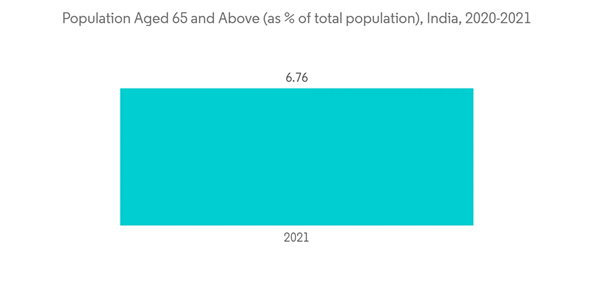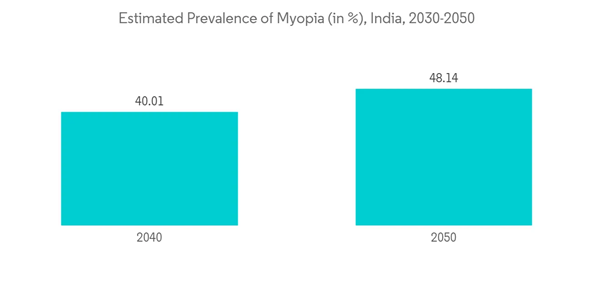The COVID-19 pandemic was an unprecedented health concern that affected every sector in different ways. The WHO alerted the pandemic as a public health issue but in India, most ophthalmologists were not seeing the patients as the government imposed a nationwide lockdown during the pandemic. That is attributed to the high risk of transmission of SARS-CoV-2 during ophthalmic procedures. In December 2020, the MoHFW, the Government of India, released guidelines to minimize COVID-19 infection among Ophthalmologists, Ophthalmic assistants/technicians, nurses, support staff, patients, and their attendants. In addition, according to these guidelines, eye care facilities in containment zones were to remain closed, and only outside containment zone were allowed to open. This significantly impacted the demand for ophthalmic procedures and devices in the country. However, currently, as the pandemic subsided, the patient inflow in ophthalmic centres increased, and it was expected to pose a strong growth during the forecast period of the study.
Factors such as growing cataract surgeries volume, technological advancements in the field of ophthalmology, and rising geriatric population are expected to enhance the growth of the studied market during the forecast period of the study.
Ophthalmology-based diseases in India are increasing. For instance, according to an article published by the Indian Journal of Ophthalmology in May 2021, a study was conducted which showed that the crude and overall age-adjusted prevalence for any positive dry eye disease symptom was 6.5% and 6.8% in males and females respectively. Furthermore, according to an article published by the Lancet Global Health in October 2022, a study was conducted which showed the overall national prevalence of diabetic retinopathy was found to be around 12.3% in India. This showed that there is a significant and growing burden of ophthalmic diseases in India.
Furthermore, as per the 2021 statistics by the Ministry of Statistics and Program Implementation (MoSPI), India, the number of females and males in the elderly population is projected to reach 100.9 million and 92.9 million by 2031 respectively. Such an anticipated increase in the elderly population growth rate is also associated with th increasing number of cataract surgeries performed per year that, in turn, indicates the rising demand for ophthalmic devices in the country. For instance, in May 2022 as per the Union Helath Minister of the country, the country requires 49 lakh surgeries to clear the backlog of blindness due to cataract and 53.63 lakh surgeries are needed to clear the backlog of severe visual impairment due to cataract.
Therefore, owing to the aforementioned factors, the studied market is anticipated to witness growth over the analysis period. However, the lack of skilled professionals and the lack of awareness about ophthalmic diseases is likely to impede the market's growth.
India Ophthalmology Devices Market Trends
The Glaucoma Surgery Devices Segment is Expected to Hold A Significant Share in the Market Over the Forecast Period
Glaucoma surgery devices are used in the treatment of glaucoma disorder. Glaucoma disorder is characterized by progressive and irreversible damage to the optic nerve and is the leading cause of irreversible blindness in India.According to the National Health Portal of India in March 2022, glaucoma is the leading cause of irreversible blindness in India, with at least 12 million people affected and nearly 1.2 million people blind from the disease. Thus, the number of patients in India suffering from glaucoma is increasing with the growing population. Such patients undergo surgery to treat glaucoma and are contributing to the rising demand for glaucoma surgical devices, including glaucoma drainage devices. Glaucoma drainage devices are the most used second-line surgical interventions for glaucoma.
In addition, the introduction of micro-invasive glaucoma surgery (MIGS) has allowed for improved management of patients with mild to moderate glaucoma. The field of MIGS has expanded rapidly in the last decade, owing to the ability of ophthalmic surgeons to tailor surgical approaches. This has augmented the usage of MIGS surgery devices in India. MIGS devices provide reduced surgery time, shorter recovery periods, affordability, and a low risk of post-surgical complications.
Moreover, presently, Selective Laser Trabeculoplasty (SLT) and Argon Laser Trabeculoplasty (ALT) are the commonly preferred glaucoma procedures in India, indicating a consistent demand for glaucoma surgery devices used in these procedures in the country. Therefore, the growth of the market is expected to be fueled by the growing demand for glaucoma surgery devices brought about by the aforementioned causes.
Spectacles Segment is Expected to Hold A Significant Share in the Market Over the Forecast Period
The major factors driving the growth of the spectacles segment are the increasing awareness among people about the use of spectacles, the rising prevalence of eye disorders, and the increasing geriatric population.The rising prevalence of myopia and hypermetropia is the major factor driving the growth of the segment. For instance, according to an article published by PubMed Central in January 2022, 2 school-based studies were conducted in Delhi which included 5 to 19-year-old children, which documented a prevalence of myopia from 2.5% to 13%. The third population-based study noted a prevalence of 7.4% in 5 to 15-year-old subjects.
Moreover, according to an article published by the Asian journal of pharmaceutical and clinical research in April 2022, a cross-sectional study was conducted in India which showed that the cumulative prevalence of refractive errors was 35.21% among the students. The distribution among the type of refractive errors was: Myopia - 65.07%, Hypermetropia - 14.89%, and Astigmatism - 20.04%, and the prevalence among the male and female students was 34.91% and 35.55%, respectively. Hence, the rising prevalence of refractive disorders like myopia and hypermetropia will increase the adoption of spectacles, thus driving the growth of the segment.
Furthermore, product launches by key market players are also boosting the segment growth. For instance, in July 2022, EyeMyEye launched one of India's first ever range of color blind glasses.
Hence due to the aforementioned factors, the spectacles segment is expected to experience growth during the forecast period of the study.
India Ophthalmology Devices Market Competitor Analysis
The Indian Ophthalmology Devices market is highly fragmented, and it consists of a number of major players. Companies, such as Alcon Inc., Bausch Health Companies Inc., Johnson & Johnson, and Carl Zeiss Meditec AG, among others, hold substantial market shares in the ophthalmic device market. Furthermore, in August 2022, Swaraashi Netralya introduced two state-of-the-art ophthalmic devices 3nethra neo HD FA and the Mirante SLO/OCT in India. In regions far from medical facilities, these gadgets aid in the diagnosis of a wide range of ocular diseases affecting both children and adults.Additional benefits of purchasing the report:
- The market estimate (ME) sheet in Excel format
- 3 months of analyst support
This product will be delivered within 2 business days.
Table of Contents
Companies Mentioned (Partial List)
A selection of companies mentioned in this report includes, but is not limited to:
- Alcon Inc.
- Bausch Health Companies Inc.
- Carl Zeiss Meditec AG
- Essilor International SA
- Hoya Corporation
- Johnson & Johnson
- Nidek Co. Ltd
- Topcon Corporation
Methodology

LOADING...










